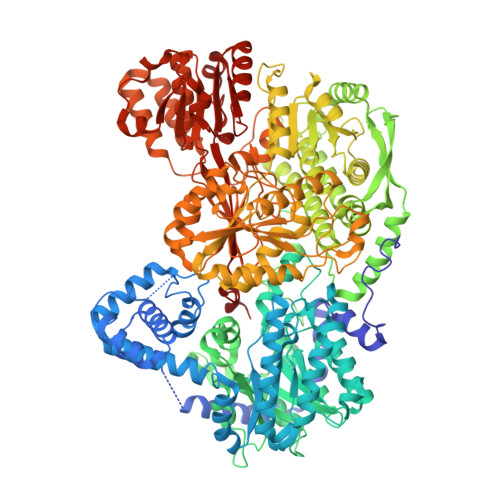Structural analysis of prolines and hydroxyprolines binding to the l-glutamate-gamma-semialdehyde dehydrogenase active site of bifunctional proline utilization A.
Campbell, A.C., Bogner, A.N., Mao, Y., Becker, D.F., Tanner, J.J.(2020) Arch Biochem Biophys 698: 108727-108727
- PubMed: 33333077
- DOI: https://doi.org/10.1016/j.abb.2020.108727
- Primary Citation of Related Structures:
6X99, 6X9A, 6X9B, 6X9C, 6X9D - PubMed Abstract:
Proline utilization A (PutA) proteins are bifunctional proline catabolic enzymes that catalyze the 4-electron oxidation of l-proline to l-glutamate using spatially-separated proline dehydrogenase and l-glutamate-γ-semialdehyde dehydrogenase (GSALDH, a.k.a. ALDH4A1) active sites. The observation that l-proline inhibits both the GSALDH activity of PutA and monofunctional GSALDHs motivated us to study the inhibition of PutA by proline stereoisomers and analogs. Here we report five high-resolution crystal structures of PutA with the following ligands bound in the GSALDH active site: d-proline, trans-4-hydroxy-d-proline, cis-4-hydroxy-d-proline, l-proline, and trans-4-hydroxy-l-proline. Three of the structures are of ternary complexes of the enzyme with an inhibitor and either NAD + or NADH. To our knowledge, the NADH complex is the first for any GSALDH. The structures reveal a conserved mode of recognition of the inhibitor carboxylate, which results in the pyrrolidine rings of the d- and l-isomers having different orientations and different hydrogen bonding environments. Activity assays show that the compounds are weak inhibitors with millimolar inhibition constants. Curiously, although the inhibitors occupy the aldehyde binding site, kinetic measurements show the inhibition is uncompetitive. Uncompetitive inhibition may involve proline binding to a remote site or to the enzyme-NADH complex. Together, the structural and kinetic data expand our understanding of how proline-like molecules interact with GSALDH, reveal insight into the relationship between stereochemistry and inhibitor affinity, and demonstrate the pitfalls of inferring the mechanism of inhibition from crystal structures alone.
- Department of Biochemistry, University of Missouri, Columbia, MO, 65211, United States.
Organizational Affiliation:






















